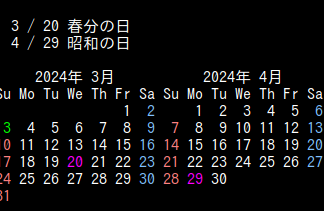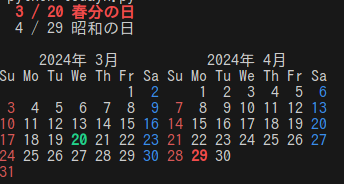1.はじめに
conky上にカレンダーを表示し、確実に当日だけをマークすることは実現できましたが、どうしてもカラー表示をしたいと思い、Python初心者なれどやってみました。コードをコピーしただけでも実現できるのだが、以下のような修正を加えました。
- 当日を新たなカラーで表示する
- 祝日名を表示し、該当する日は祝日名もカラーで表示する
- 2ヶ月表示する
- 祝日名の日付を00表示から0表示に変更するとともに、表示サンプルを京指し直しました
- 過去になった祝日名は表示しないように修正しました(2024/10/15)
参考にさせていただいたのは、 https://mackro.blog.jp/archives/8858668.html です。ありがとうございました。
2.使った手法
(1)コードの流れ
大きくは、
- カレンダーの各月をリスト化し、更に隔週ごとのリストを要素とする2次元リストを作成する。
- 各日を取り出しながら、jpholidayのコードを利用して、祝日か?日曜日か、土曜日か?を判定しカラーコード付きの日にちを 、14 日毎に改行コードとともにoutput 変数に 入れておいて、最後に一気に書き出す。
- 祝日名は、output が実行される前に、print 文で カレンダーの出力前に書き出しておく。
- 5週と6週の月があるので、zip_longest 関数を利用して、6週の方に合わせる。その際、5週の月は「 None 」が出力される。このあたりはhttps://www.lifewithpython.com/2016/06/python-zip-longer-list.html がわかりやすい。
- このままだとエラーになるので None は [0, 0, 0, 0, 0, 0, 0, 0] のリストで置き換える。
(2)処理の流れ(カレンダーの表示部)
上記の流れに沿って、各月のリスト以下のように作られます。
[[0, 0, 0, 0, 1, 2, 3], [4, 5, 6, 7, 8, 9, 10], [11, 12, 13, 14, 15, 16, 17], [18, 19, 20, 21, 22, 23, 24], [25, 26, 27, 28, 29, 0, 0]] # 2024年2月のリスト 5週の月
[[0, 0, 0, 0, 0, 1, 2], [3, 4, 5, 6, 7, 8, 9], [10, 11, 12, 13, 14, 15, 16], [17, 18, 19, 20, 21, 22, 23], [24, 25, 26, 27, 28, 29, 30], [31, 0, 0, 0, 0, 0, 0]] # 2024年3月のリスト 6週の月 これを1日毎に取り出し、各日を祝日か、日曜日か、土曜日かの判定に入るのですが、そのままだと要素の少ない2月に回数に合わせられるので、3月の最終週は取り出しできないことになります。
[0, 0, 0, 0, 1, 2, 3] [0, 0, 0, 0, 0, 1, 2] # 2月と3月の第1週目
[4, 5, 6, 7, 8, 9, 10][3, 4, 5, 6, 7, 8, 9]
:
(省略)そこで zip_longest 関数で要素の数が多い6週の月にあわせると 、今度は要素の少ない2月の最終週がNone でとなります。
None [31, 0, 0, 0, 0, 0, 0] # 2月と3月の最終週このままではエラーになるのでNone は [0, 0, 0, 0, 0, 0, 0]に入れ替えます。
[25, 26, 27, 28, 29, 0, 0][24, 25, 26, 27, 28, 29, 30] # 2月と3月の第5週目 [0, 0, 0, 0, 0, 0, 0][31, 0, 0, 0, 0, 0, 0] # 2月と3月の第6週目 実際は2月の第6周目は存在しない
(3)処理の流れ(祝日名の取得関係)
以前の処理では、カレンダーの表示処理の途中で、その日が祝日に当たると判断されたら祝日名も取得、カレンダーの表示の前に print 文で 書き出しておくことにしていました。
使用するのは between メソッドです。
なお、月の最終日を取得する方法については、Pythonで月初・月末(初日・最終日)、最終X曜日の日付を取得を差参考にさせていただきました。
last_day = datetime.date(next_year, next_month, calendar.monthrange(next_year, next_month)[1])last_day = int(last_day.strftime("%d"))
holiday = jpholiday.between(datetime.date(year,month,1),datetime.date(next_year,next_month,last_day))
# holiday 変数に 当月と翌月の末日までの祝日を取得これと実行すると以下のような型の値が取得できます。
2024-03-20春分の日
<class 'datetime.date'> <class 'str'>これから datetime.date 型の日付と str 型の 祝日名を分離、取り出します。
for i,n in holiday: # i = 日付 n = 祝日名
i = i.strftime("%m / #d") # 日付だけを %m/%d 型に変換
print(" " , i, " " , n) # 若干の整形をしながら出力します3.実際のコード
import calendar
from datetime import datetime
from datetime import date
import datetime
import jpholiday
import sys
from dateutil.relativedelta import relativedelta
from itertools import zip_longest
def output_calendar(target="terminal"):
# 祝日、日曜日、土曜日の色を指定
color_code = {
"holiday": "\033[1;91m",
"sunday": "\033[31m",
"saturday": "\033[94m",
"today": "\033[1;32m", # "\033[1;32;47m",で反転表示したいが、2桁だけ反転表示することができない。
"end": "\033[0m"
}
# Conkyの場合
if target == "conky":
color_code = {
"holiday": "${color ff00ff}",
"sunday": "${color ff8080}",
"saturday": "${color 80c0ff}",
"today": "${color 00ff00}",
"end": "${color}"
}
d = date.today() # date(2024,12,1) # テスト用
next_month = int((d + relativedelta(months=1)).strftime("%m"))
ne_next_month = int((d + relativedelta(months=2)).strftime("%m"))
next_year = int((d + relativedelta(months=12)).strftime("%Y"))
year = int(d.strftime("%Y"))
month = int(d.strftime("%m"))
today = int(d.strftime("%d"))
# 12月時の翌月を翌年の翌月にする
if month != 12:
next_year=year
else:
next_year=next_year
# 祝日名の取得
last_day = datetime.date(next_year, next_month, calendar.monthrange(next_year, next_month)[1])
last_day = int(last_day.strftime("%d"))
holiday = jpholiday.between(datetime.date(year,month,1),datetime.date(next_year,next_month,last_day))
for i,n in holiday:
if i >= d: # 当日及び将来の祝日名のみ表示
if i == d:
i_m = i.strftime("%-m")
i_d = i.strftime("%-d")
i = format(i_m,">2") + " / " + format(i_d,">2")
print("",color_code["holiday"], i, n , color_code["end"])
else:
i_m = i.strftime("%-m")
i_d = i.strftime("%-d")
i = format(i_m,">2") + " / " + format(i_d,">2")
print(" ",i, n)
else:
None
# 週の始まりの曜日を指定
calendar.setfirstweekday(calendar.SUNDAY)
# 日付を週ごとのリストにして変数に代入
days = calendar.monthcalendar(year, month)
next_days = calendar.monthcalendar(next_year, next_month)
# jpholidayの処理との競合を避けるため値を戻す
calendar.setfirstweekday(calendar.MONDAY)
# カレンダーを出力
output = "\n {}年 {}月".format(str(year), str(month)) + " {}年 {}月\n".format(str(next_year), str(next_month))
output += " Su Mo Tu We Th Fr Sa" + " Su Mo Tu We Th Fr Sa\n"
for (line, next_line) in zip_longest(days,next_days):
if line is None:
line = [0,0,0,0,0,0,0]
#print(line)
#print(next_line)
for i in range(7):
str_day = str(line[i]).rjust(3)
if line[i] == 0:
output += " "
elif jpholiday.is_holiday(datetime.date(year, month, line[i])):
if jpholiday.is_holiday(datetime.date(year, month, line[i])) and (int(str_day) != today):
output += color_code["holiday"] + str_day + color_code["end"]
else:
output += color_code["today"] + str(str_day) + color_code["end"]
# 日曜日の場合色分け
elif i == 0 and (int(str_day) != today):
output += color_code["sunday"] + str_day + color_code["end"]
# 土曜日の場合色分け
elif i == 6 and (int(str_day) != today):
output += color_code["saturday"] + str_day + color_code["end"]
else:
if int(str_day) == today: # 当日のマーキング
output += color_code["today"] + str(str_day) + color_code["end"]
else:
output += str_day
if next_line is None:
next_line = [0,0,0,0,0,0,0]
for x in range(7):
str_next_day = str(next_line[x]).rjust(3)
if next_line[x] == 0:
output += " "
# 翌月の祝日を判定し色分け
elif jpholiday.is_holiday(datetime.date(next_year, next_month, next_line[x])):
output += color_code["holiday"] + str_next_day + color_code["end"]
# 翌月の日曜日の場合色分け
elif x == 0:
output += color_code["sunday"] + str_next_day + color_code["end"]
# 翌月の土曜日の場合色分け
elif x == 6:
output += color_code["saturday"] + str_next_day + color_code["end"]
else:
output += str_next_day
output += "\n"
return output
if __name__ == '__main__':
# コマンドライン引数を取得
try:
argument = sys.argv[1]
except:
argument = None
# カレンダーを出力
print(output_calendar(argument))
4.出力結果
コマンドライン上では

conky上では

祝日に当たると


Comments powered by CComment